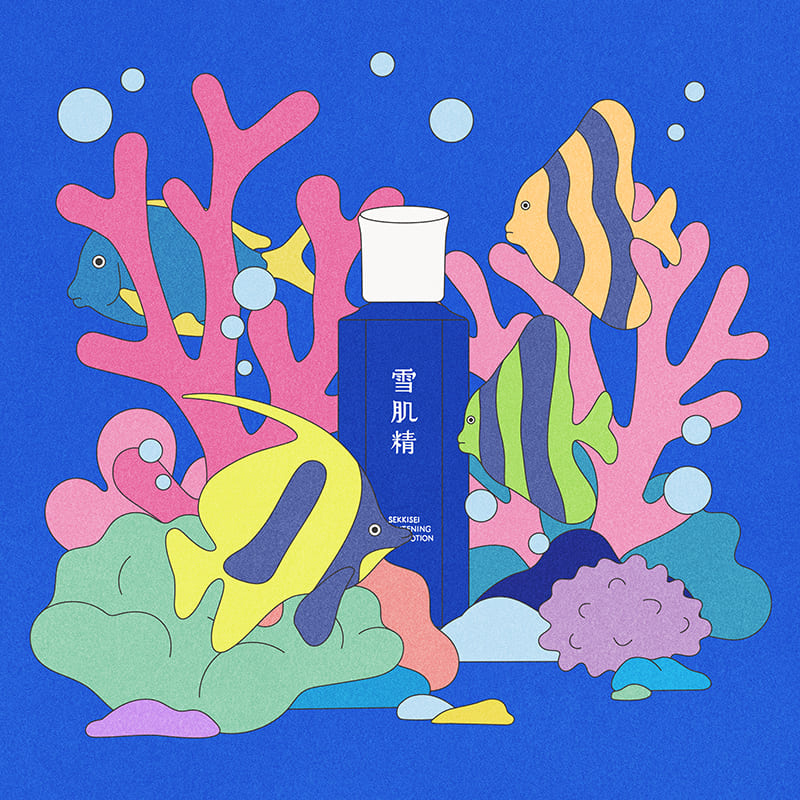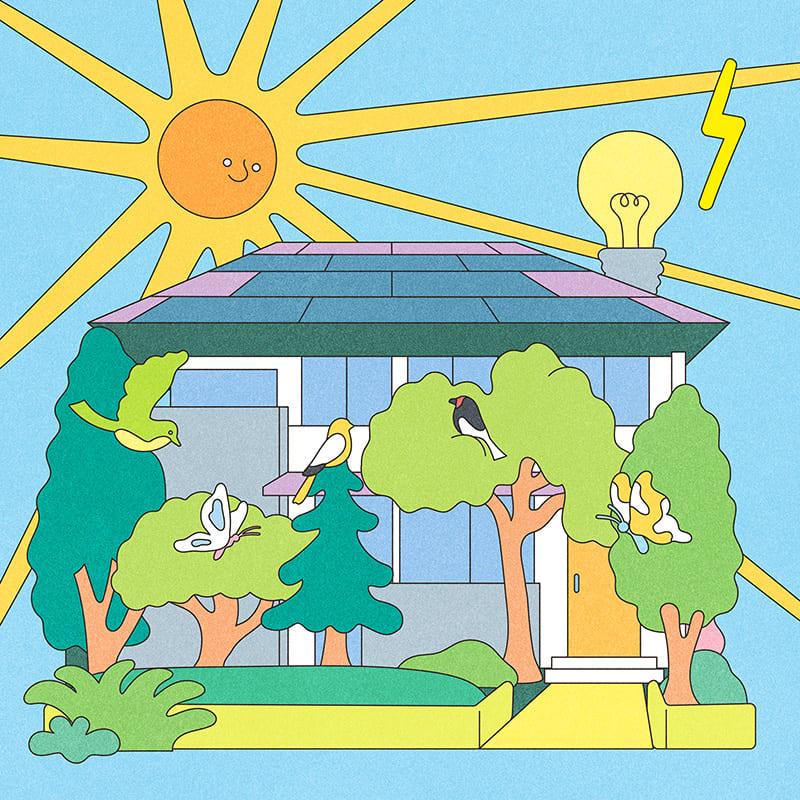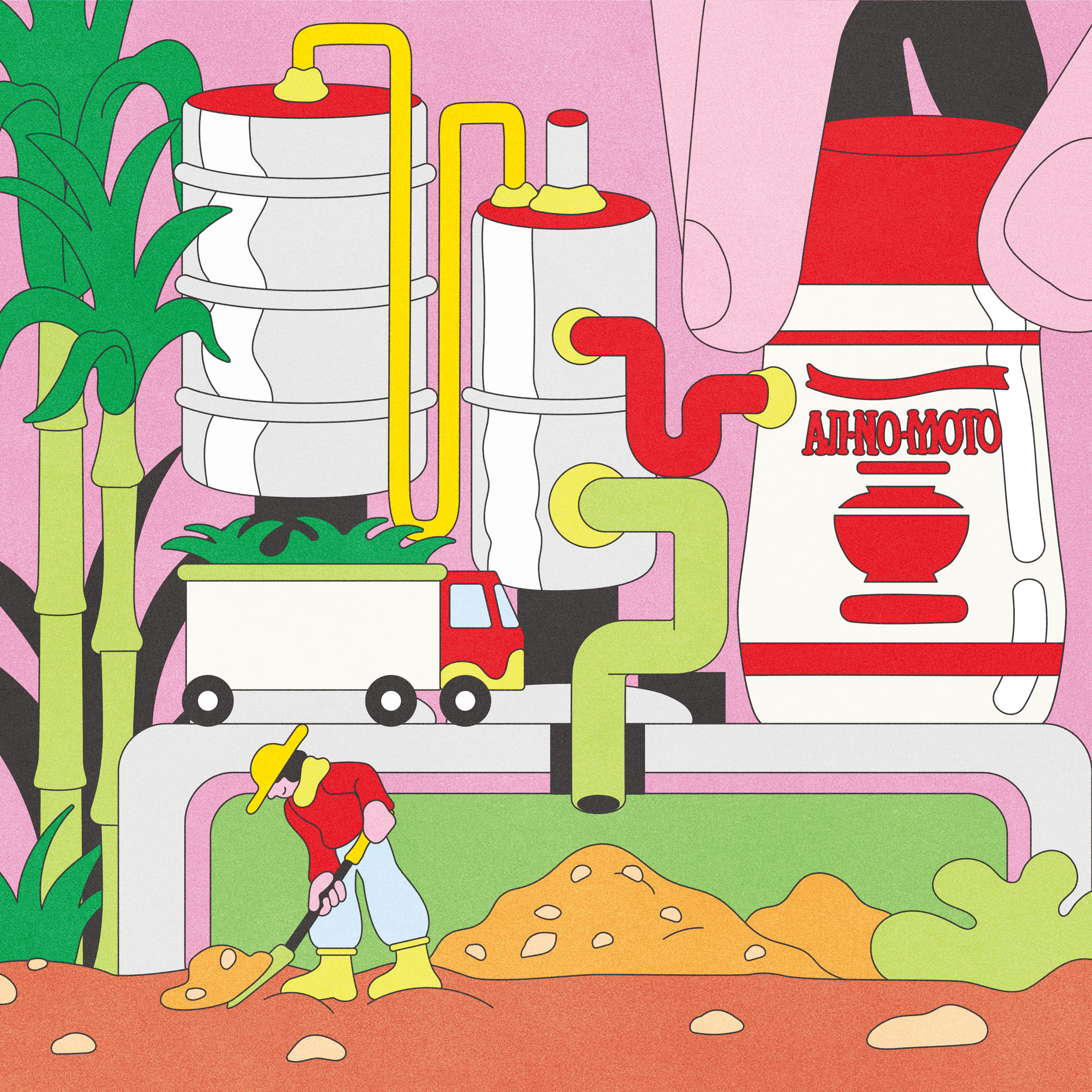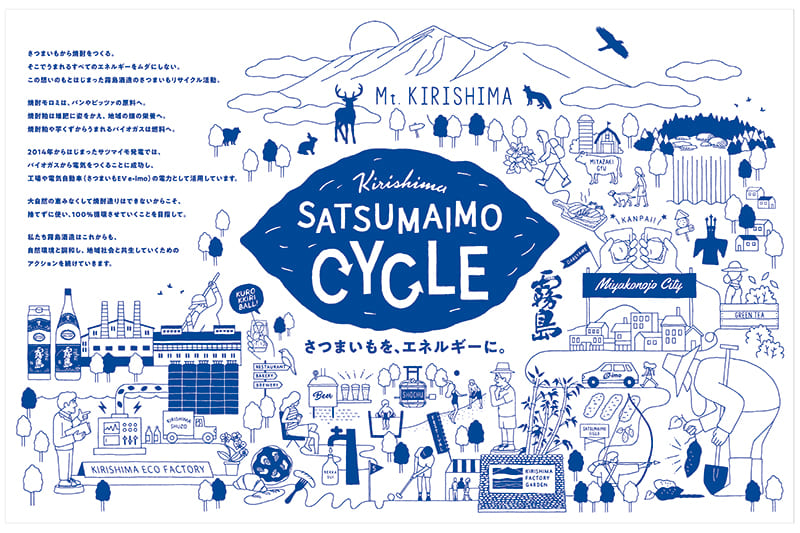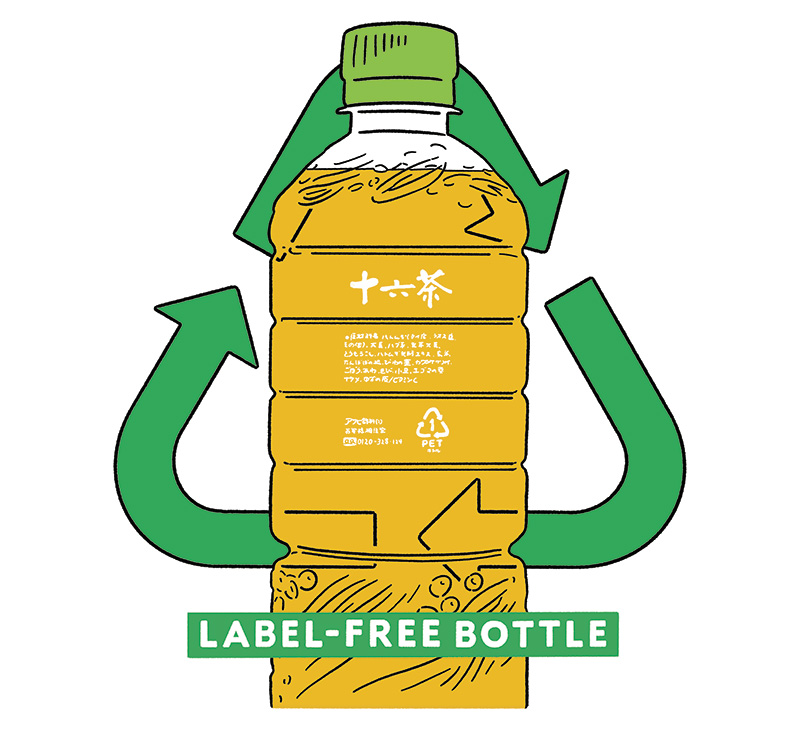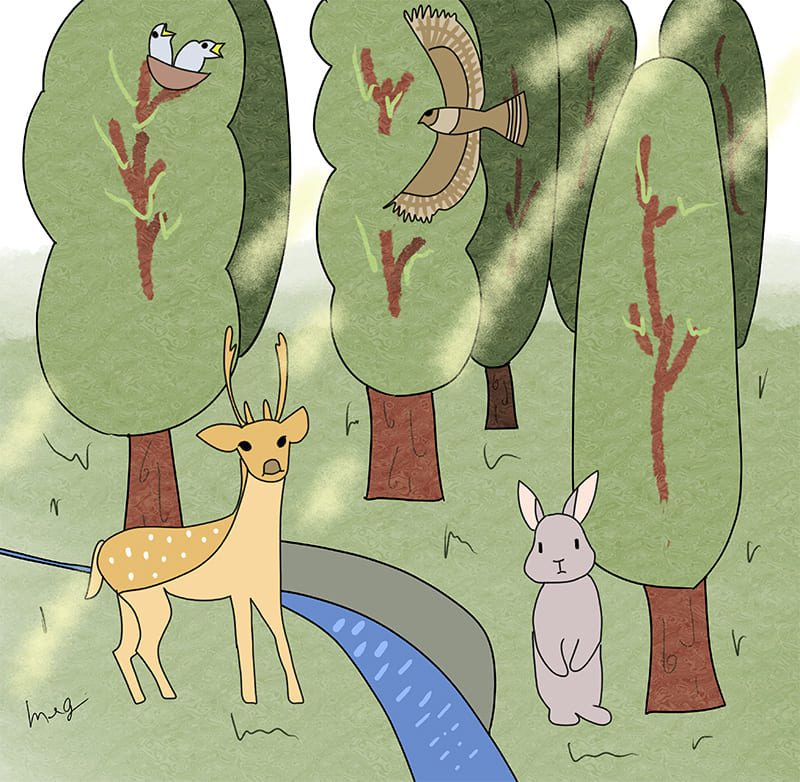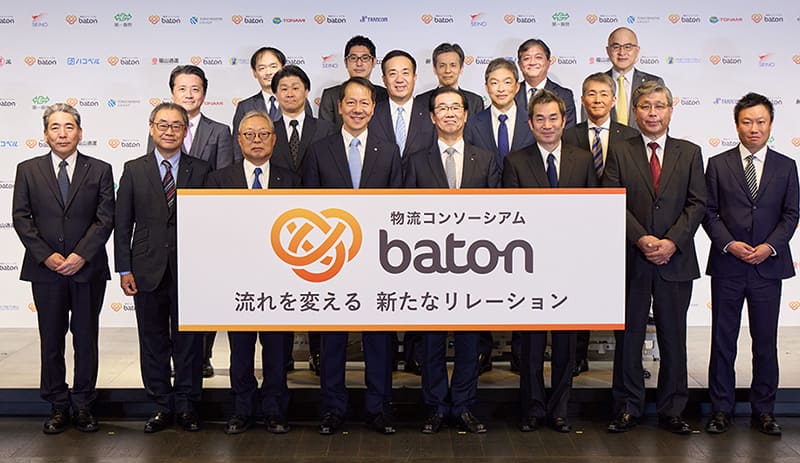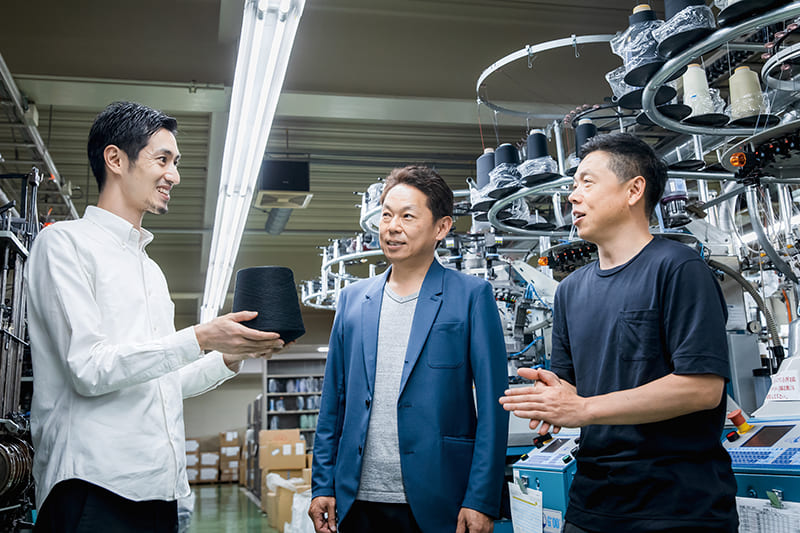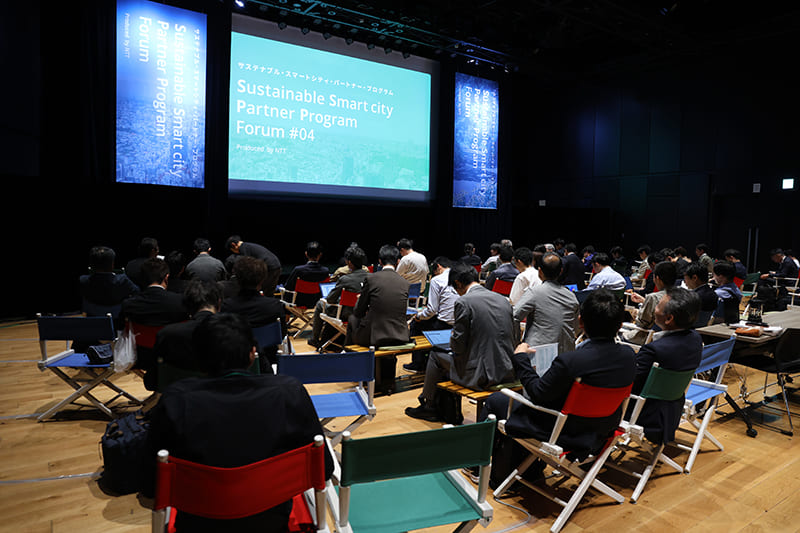October 25, 2024
Benesse provides all-round support for well-being
VOL. 13: Benesse Holdings Inc.
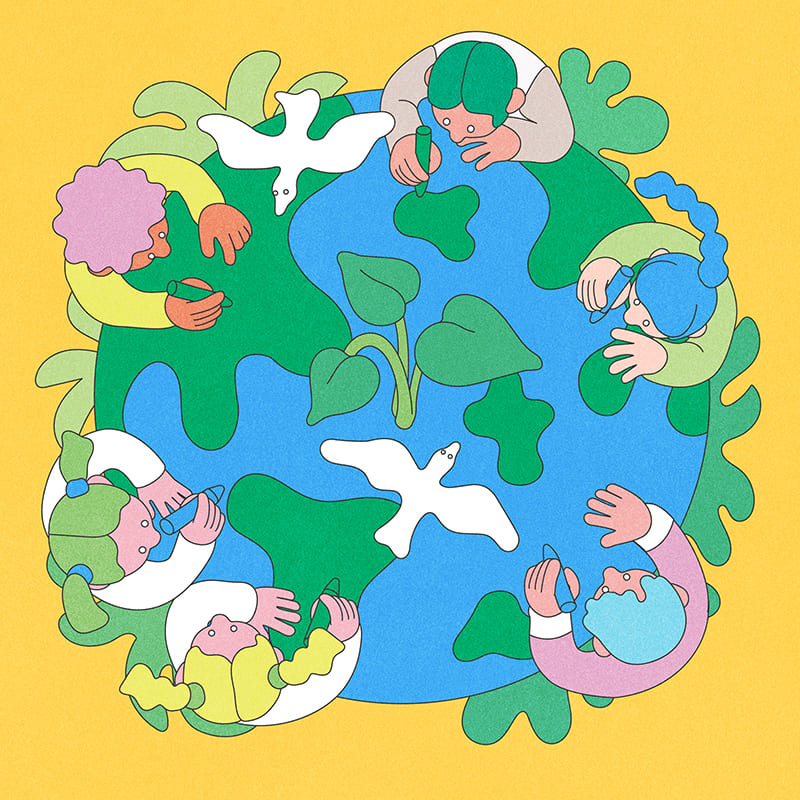
Benesse’s strong points
1.Changed name to Benesse, a Latin-derived coinage meaning “well-being”
2.First Japanese education provider to endorse the U.N.’s Task Force on Climate-related Financial Disclosures; made CDP’s 2023 climate change A List
3.Promotes digitalization in its mainstay correspondence course business and contributes to the reduction in paper and plastic consumption as well as the use of transportation
4.Works to raise awareness among children, who in the future will play roles in achieving the U.N.’s sustainable development goals, by offering a variety of environmental education programs
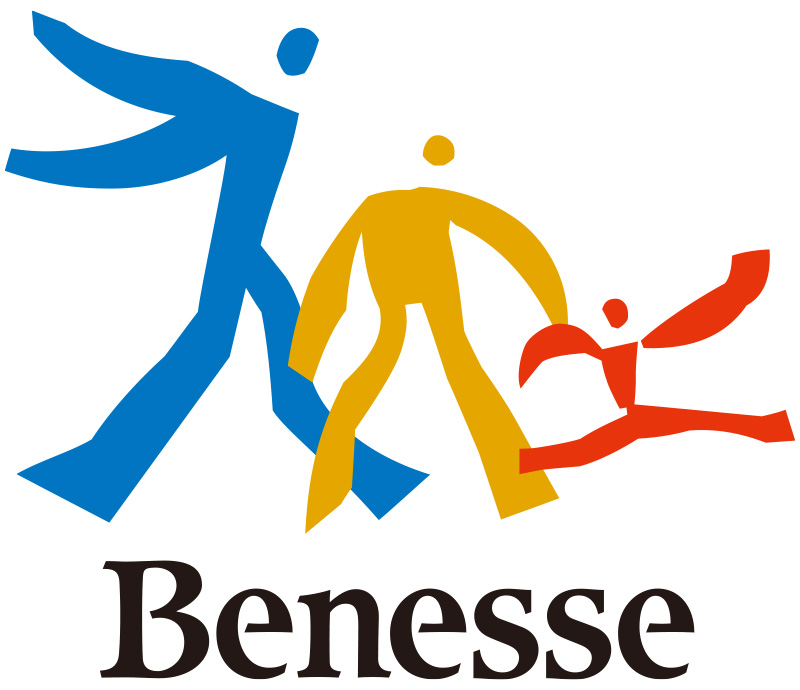
It is difficult to summarize in one word Benesse Holdings Inc.’s business, which accompanies people through all phases of their lives, from conception to old age.
The company traces its origin to the founding of the Fukutake Publishing Co. in 1955. It initially published educational materials and student pocketbooks for junior high school students, then expanded its business to include practice exams. Its Shinken Zemi correspondence courses for primary and high school students drove rapid growth for the company, whose mainstay businesses today include print and digital media on pregnancy and childbirth, plus providing nursing care for the elderly.
What ties these businesses together is the corporate philosophy of “Benesse = well-being,” from the Latin bene (well) and esse (being). This is also the direction that the U.N.’s sustainable development goals are aiming for. In that sense, one may describe Benesse as a well-being company rather than an education-service company.
And that is exactly what made it “imperative” for Benesse to attach importance to efforts for sustainability, according to Keiko Toyoizumi, a Benesse executive officer who also serves as vice general manager of the corporate communications division (see the article in the box).
In 2018, Benesse established a sustainability promotion committee, which is aimed at strengthening efforts across the group to help make our society more sustainable. The next year, it became Japan’s first education provider to endorse the recommendations of the U.N.’s Task Force on Climate-related Financial Disclosures.
Benesse’s proactive stance was recognized by the international nonprofit organization CDP, which selected it among the A List companies, the highest rating, based on a survey on climate change efforts, for three consecutive years from 2018. Benesse also made the 2023 A List, announced last February.
In April 2024, Benesse Corp., one of its main operating companies, was recognized by the Ministry of the Environment as an “eco-first” company. Benesse Corp. is currently working to reduce environmental impacts, aiming to reduce Scope 1 and 2 direct and indirect greenhouse gas emissions by 100% from the fiscal 2018 level by fiscal 2041, and Scope 3 other indirect emissions by 39.4% by fiscal 2050.
One of the initiatives unique to Benesse is its digitalization strategy for products and services.
Digitalizing materials
For many years, Benesse’s mainstay correspondence course business involved mailing huge amounts of printed educational materials and direct mail. The total was the second-largest among Japanese companies. The transportation and waste associated with this were major factors that increased the company’s Scope 3 emissions.
Benesse has addressed this most difficult problem by reforming its business model.
In 2014, it introduced digital courses to the Shinken Zemi correspondence courses. Teaching materials, which were previously sent by post, are now received on a special tablet device, and a check-and-correct service, called the Red Pen Teacher, can be provided on the device. The new service significantly shortens the time it takes before users receive corrections on projects and reduces CO2 emissions associated with transportation and disposal.
Reforming a service that had been based on analog culture for decades was a difficult undertaking, as it required convincing users. But Benesse patiently worked to convince them of the advantages. As a result, primary and junior high users of the digital materials, which represented about 34% of the total in fiscal 2018, increased to about 70% three years later. In fiscal 2023, the company also successfully halved the amount of paper consumed from the level in 2014.
Still, the amount of paper used by Benesse totaled 34,088 tons in fiscal 2023, representing about 0.6% of the total output of paper for printing and information uses in Japan.
“We could aim to completely digitalize these courses, but there are always a certain number of people who think printed materials are better for learning,” Toyoizumi said. “For these people, we aim to introduce enhancements to the individualized learning enabled by digital teaching materials and showcase the advantages not available with printed materials.”
Benesse’s efforts have paid off. Its paper usage decreased 10.9% from a year earlier to the 34,088 tons in fiscal 2023. It has also digitalized areas other than teaching materials.
“We have also significantly reduced the number of direct mail items sent and the amount of paper used,” Toyoizumi said. “Previously, we delivered 15 to 20 DVD materials each year (for every grade) but have since switched to a system where users scan a QR code with their smartphones or other devices to play videos.”
Although she declined to disclose specific impacts of introducing this method, terming the information a “corporate secret,” she said the amount of DVD deliveries “has declined significantly.” Benesse still sends direct mail, but the frequency has decreased and the booklets have grown thinner after it introduced the QR system. Furthermore, the company began in November 2022 to use biomaterials for the plastic envelopes used in direct mail. This increases costs, but Benesse went ahead on the insistence of Representative Director, President and CEO Hitoshi Kobayashi, according to Toyoizumi.
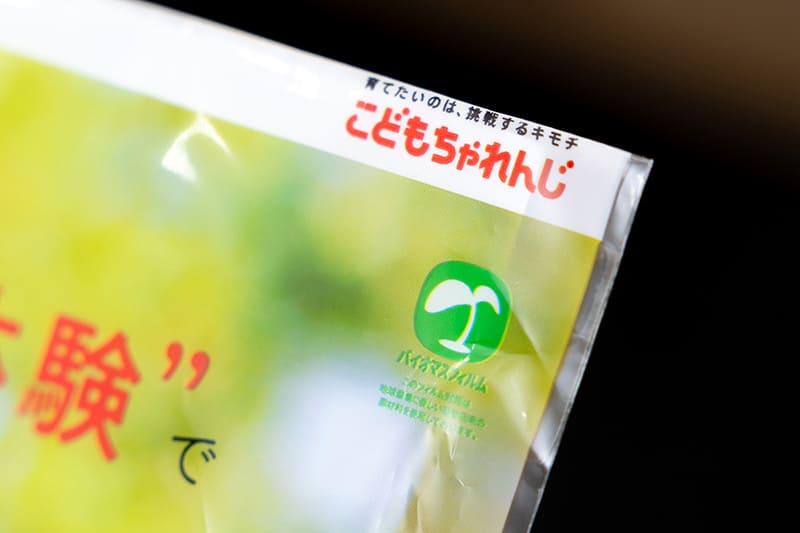
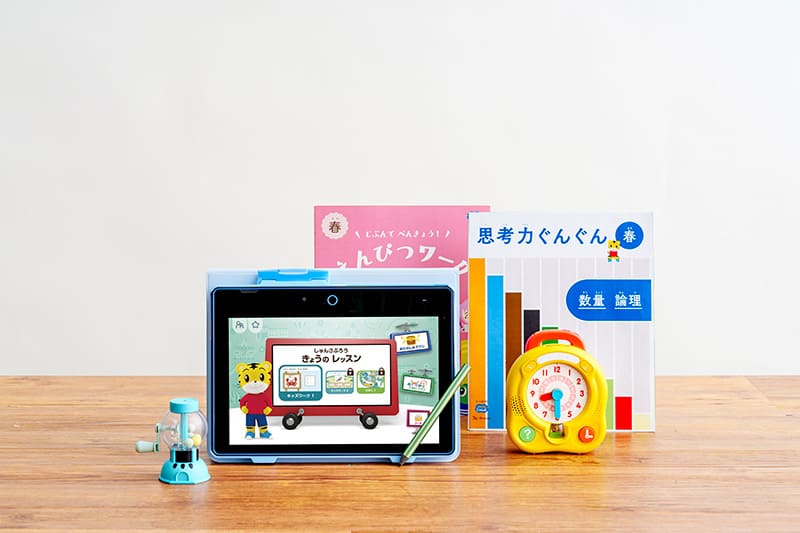
A set of Kodomo Challenge correspondence course educational materials with a tablet. The photo on the left shows a logo indicating that the wrapping material is biomass.
©BENESSE, PHOTO: HIROMICHI MATONO
Reusing and recycling
Benesse also puts effort into reusing and recycling teaching materials to help realize a circular economy.
In 2023, it began reusing tablet devices for digital teaching materials. It has already recovered more than 70,000 such devices and reused about 26,000 after refurbishing them (as of Aug. 31).
By reusing the tablets, the company can reduce the usage of such resources as oil, the raw material for plastics, and rare metals used in circuit boards, as well as reduce CO2 emissions from production processes. Benesse estimates that reusing a device cuts annual CO2 emissions by 42.5 to 46.5 kilograms.
In the Kodomo Challenge correspondence course for preschoolers, it launched in 2010 the Kurukuru Recycling program for plastic, wood and fabric educational toys that it distributes as educational materials.
For courses for preschoolers who cannot read or write, the main educational materials are educational toys sent monthly. Although they are popular, they become unneeded as children outgrow them.
The company thus began setting up collection boxes at venues of concerts and other events for Kodomo Challenge subscribers. By the end of fiscal 2023, it had collected a total of about 17.1 tons. Collected materials are recycled into oil to be used as an energy source.
“Children say thank you to the toys that used to be dear to them but are no longer needed, and return them to the collection box for their rebirth. This is a special event, different from just throwing them away,” Toyoizumi said. “Parents have told us that it’s great for their children’s education.”
Another benefit of the Kurukuru Recycling program is that it can be a catalyst for children’s greater awareness and behavioral changes, according to Toyoizumi.
Recycling has an “environmental education” aspect, which has been established as an approach unique to Benesse.
Oyako Mirai project
In 2008, Benesse launched the Oyako Mirai (parent-child future) project, marking the 20th anniversary of the launch of Kodomo Challenge. The project is aimed at giving parents and their children the opportunity to think together about the importance of the environment and living things. Under this project, the company has introduced wide-ranging content and initiatives related to environmental education through learning materials and events.
First, Shimajiro, a popular cartoon character from Kodomo Challenge, and the Shimajiro Car, designed after the tiger cub, toured 47 prefectures to hold nature events in which children can experience the importance of the environment and living things. Over the course of a year, they traveled 17,970 kilometers and interacted with 3,641 parents and children.
The project delivered to day care facilities across Japan a kankyō kamishibai (environmental picture story show) kit that plainly explains the concept of mottainai, a word expressing a sense of guilt for the act of wasting, and the importance of protecting the environment, as well as materials to be used at home to review what has been learned. When the project was offered to kindergartens in fiscal 2008, it proved popular and was used at about 3,300 facilities, representing 25% of all kindergartens in Japan. The next year, the project’s scope was expanded to include nursery schools, and picture story kits and learning materials were delivered to about 7,000 facilities nationwide.
The project also offered environmental education to existing Kodomo Challenge subscribers. It incorporated environmental themes into its regular illustrated teaching materials in a way that naturally allowed parents and children to learn together what mottainai is all about. In addition, the project was enlivened by the distribution to subscribers of booklets on the themes of the environment and food education, as well as the distribution of more than 1 million eco-friendly traditional furoshiki wrapping cloths.
This project was the catalyst for Benesse to begin actively leveraging its points of contact with children to develop human resources who can contribute to achieving the U.N.’s sustainable development goals. Toyoizumi, who was at the time one of the executives in charge of Kodomo Challenge, was one of the main members of this project.
Environmental education
“When we launched the Oyako Mirai Project, some people raised questions, asking, ‘Why environmental education for preschoolers?’ or ‘Will they be able to understand?’ But many young parents and guardians have high awareness on the future of the environment,” Toyoizumi said. “So we continued the project, hoping they would understand our thinking.”
Apparently many parents and guardians, as well as their children, understood.
Today, environmental education is becoming the pillar that represents Benesse, which has enhanced its offerings for preschoolers through wide-ranging media.
In 2012, a TV program for preschoolers that had aired nationwide since 1993 was renewed and renamed “Shimajiro no Wow!” It has since conveyed the importance of biodiversity and protecting the environment. The program received international recognition when it was recognized as the best preschool program in the Asian Television Awards, one of the largest award programs in Asia. In addition, Shimajiro videos conveying the idea of mottainai have become popular online, with hundreds of thousands to millions of views on YouTube.
The list goes on for Benesse’s environmental education initiatives, but let us conclude by mentioning the Summer Challenge: Nationwide Primary School Students’ “Future” Creation Competition, a major event.
Since 2004, Benesse has held the annual competition during summer vacation, inviting primary school students to submit works including research reports and paintings, and giving the best ones awards. In 2008, an environmental category was added to this program in connection with the Oyako Mirai Project. Over the years, the total number of essays, research reports, paintings and other works has reached more than 1 million.
Last summer, the 20th anniversary of the program, approximately 210 works were selected, of which 21 received grand prizes. The winner of the grand prize in the environment category for the fourth grade was research on cardboard composting in which the student tried to use cardboard to help compost vegetable scraps. It was a serious research project in which the student confirmed that both rice bran and humus are required to make compost, and tried to find the right ratio for mixing them. It also won the Minister of Education, Culture, Sports, Science and Technology Award.
Benesse is working to reduce its environmental impact by reforming its core business, and at the same time is actively involved in environmental education for children, with whom it has many contact points in its core business. Environmental education may not directly lead to reducing Benesse’s greenhouse gas emissions, but it has great significance to the future of Japan and the Earth.
Benesse’s efforts on environmental education, which began with preschoolers, have expanded to include educational materials and events for primary and high school students. In addition, it is beginning to support environmental education for society as a whole — for example, it has cooperated with Tokyo’s western Tama area on education over biodiversity.
Benesse has the know-how about easy-to-understand ways to educate children, who may not otherwise be interested, about sustainability to protect the global environment and society. It should be able to extend such know-how to wide-ranging organizations and companies that wish to introduce environmental education programs.
Asked if the company has any plans to launch a business providing support for environmental education, Toyoizumi said: “There are certainly things we do better than anybody else. Since I became an officer in charge of sustainability, I have grown more and more convinced that the type of education that only helps improve school grades is not enough to help maintain our society.”
Benesse, which supports people in their efforts to “live well,” has the potential to bring about significant changes in society as a whole, starting with environmental education. Expectations are high for the “well-being company.”
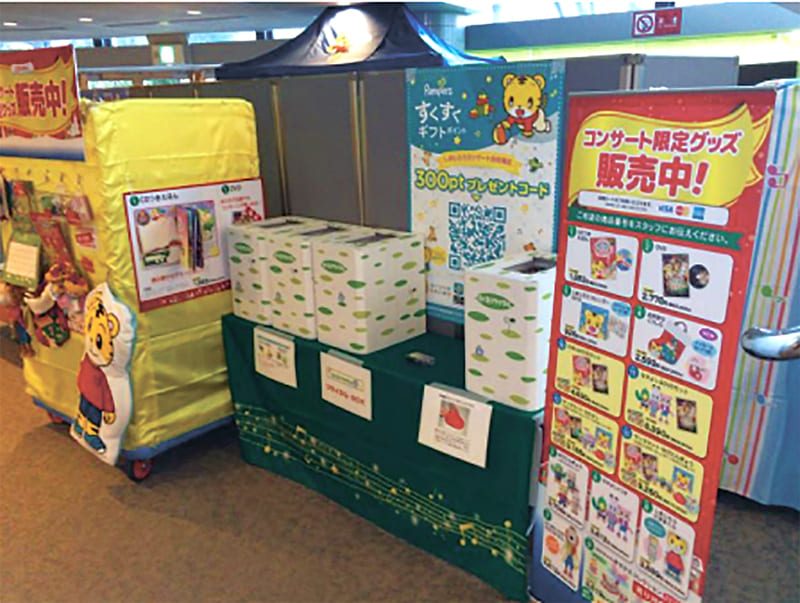
©BENESSE
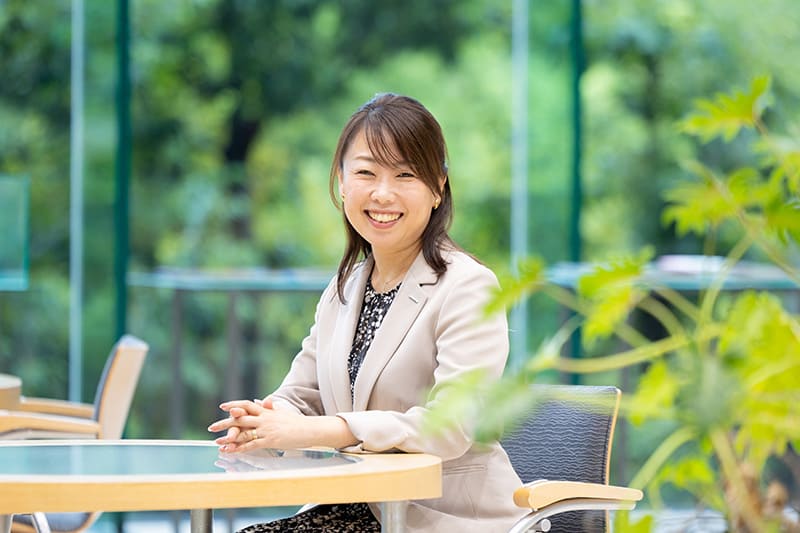
Sustainability is a natural goal
Keiko Toyoizumi
Vice general manager of corporate communications
The word “benesse” is a coinage that combines the Latin words “bene,” which means “good” or “right,” and “esse,” meaning “to live.” In 1990, we adopted “well-being” as the corporate philosophy and changed the company name to Benesse Corp. in 1995.
“Living well” is largely synonymous with “well-being.” It also reflects our determination to support people’s aspirations and their efforts to solve problems in all phases of their lives.
For about 30 years since we adopted this word as our company name, every one of our employees has continued to think about what “living well” means for our customers, who span from little children to the elderly, and what we should do to create a future in which people can live better lives.
It is obvious that people cannot “live well” unless we have a sustainable society and global environment in the first place. When the world began to move in the direction of realizing sustainability, it was a natural theme for us to arrive at.
In addition, the targets of our core business, correspondence courses, are children. We call children “exchange students from the future.” How can we afford to not take action when we know their future is in trouble? It was natural for us to eventually think about the global environment and make efforts to make it better so that our children can have a better future.
Since I joined Benesse in 1997, the more I have done work for children, the stronger I have felt the need to ensure that we do not leave a negative legacy for future generations.
Environmental destruction and resource problems are issues our generation has caused. We must pass the Earth to the next generation after our generation has returned it to its former state. At the same time, we must establish a cycle in which the generation following us will think deeply about the generation following them and create a world in which they can live well.
In that sense, I feel that it is a natural extension for us to not only teach children to study, but also provide them with environmental education at the same time.
Having adopted “well-being” as Benesse’s corporate philosophy, that makes us responsible for certain things and enables us to do certain things for children. With this in mind, we will continue our efforts for the future.
人に寄り添うウェルビーイング企業の貢献。
生命が宿った瞬間から、最期を迎える時まで。人のライフステージに寄り添うベネッセホールディングスの業種を一言で表すのは難しい。
小中高生向け通信教育の「進研ゼミ」で急成長を果たしたが、今では妊娠・出産を支えるメディア事業や、高齢者向け介護事業なども主力とする。共通するのは、ベネッセグループの企業理念であり、社名の由来でもある「よく生きる」。SDGsが目指す「ウェルビーイング」とほぼ同義だ。その意味では教育事業者ではなく“ウェルビーイング企業”と表現すべきなのかもしれない。
目標へ向かい、環境負荷低減に取り組んでいる最中。中でもベネッセらしい取り組みが、「商品・サービスのDX化戦略」だ。同社は子どもとの接点という強みを活かし、SDGsへの貢献人材の育成にも積極的に取り組む。ベネッセによるこの「環境教育」は、同社が排出するGHGの削減などに直結しないかもしれないが、日本や地球の未来にとっては大きな意味がある。“ウェルビーイング企業”への期待は大きい。
Return to Sustainable Japan Magazine Vol. 41 article list page

